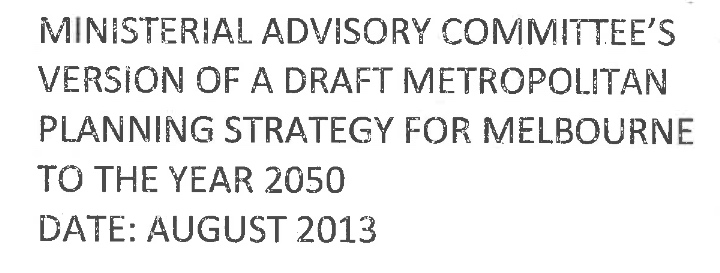 I am quoted in this Age story on the original Advisory Committee draft of Plan Melbourne, which has now been released under Freedom of Information laws after an application by former Labor staffer Andrew Herington. The full draft can be found here.
I am quoted in this Age story on the original Advisory Committee draft of Plan Melbourne, which has now been released under Freedom of Information laws after an application by former Labor staffer Andrew Herington. The full draft can be found here.
I didn’t have long to review the documents so my comments were quite high-level, but it doesn’t take long comparing the documents to get a sense of the kinds of changes made. The Departmental versions (the May 2014 final, and the October 2013 draft) are broadly similar but strip a lot of the detail out: there’s an all-pervasive softening of the language. The Advisory Committee draft is not perfect either – they were working within a highly problematic process that had, amongst other things, been largely pre-empted by other policy announcements – but it is certainly a more serious policy document.
Hopefully its release will allow more complete and detailed analysis of where the changes were made, and give some insight into the journey from strategy to coffee table book.
For the record, here are the full comments I gave to the Age:
There are certain issues with the final Plan Melbourne that are also present in this draft, generally relating to how it fitted in with broader policy decision-making. The Advisory Committee seems to have been working without final versions of some critical data (such as some housing and land supply data), and could not solve the basic problem that various critical government decisions pre-empted the strategy.
However this draft is throughout far clearer and generally more ambitious than the released plan. Specificity and ambition are hard for governments, as they create political problems. The final version of Plan Melbourne, like Melbourne 2030 before it, is vague at crucial points. This makes it safer as a political document but much less useful as a planning strategy.
The Advisory Committee version is clearer about the challenges facing Melbourne and the difficult decisions we must confront. For example, the references to threats from climate change, and the need to adapt the city in response, are more explicit.
Other points that were fudged in the released version are much clearer in the draft. For example, in discussing the “20-minute neighbourhood” it states that shops, schools, parks, jobs and services should be within 20 minutes by foot, bicycle, or using public transport. The reference to these transport modes was removed in the final version, reducing the usefulness of the concept. A neighbourhood in which a corner store is a 20 minute drive away, for example, hardly meets the original intent.
Advisory Committees are appointed to serve the Minister, and it was entirely appropriate that the government release their own strategy, rather than simply adopting the committee’s. However, given that a draft of Plan Melbourne was released for comment in October 2013, it seems a lost opportunity that the Advisory Committee version wasn’t released instead to gauge the public’s response.
It is also a shame that key passages were weakened. Strategies that duck the difficult points may be superficially appealing to government, but they simply delay the moment of confrontation. If the strategy were clearer there would be more opportunity to bring the community on the policy “journey,” and therefore more acceptance of difficult decisions when they do need to be made.
A secondary point is that the process taken to Herington strongly echoed my experience trying to get hold of the first Residential Zones Advisory Committee report. The Age report states that they initially fought his application, only to concede and release the document days before the hearing: this is exactly what they did to me (an experience I wrote about here). This is, on the face of it, an inappropriate approach to the Freedom of Information process.

